When investing in a new horsebox, we at Cooke Coachbuilders would always recommend opting for a bespoke design service so that your requirements feed into every aspect of the production of the vehicle. The issue with bespoke horsebox design however is that you can quickly become overwhelmed with the amount of choices and options you are faced with.
There’s one choice however that we would fully advise, and that is to opt for a tilt cab over a fixed cab when designing your horsebox. When it comes to horsebox production, the team at Cooke Coachbuilders operate on a ‘have it your way’ policy, but the advantages of opting for a tilt cab are so unanimous that having one installed should be considered a necessity.
Tilt cabs were first designed in the late 1950’s, in an attempt by an American logistics company to produce vehicles that were easier (and therefore cheaper) to maintain. They’ve now been adopted by shipping and courier corporations throughout the world, and are the go-to choice of cabin design for industry professionals and HGV specialists alike.
Tilt cabs (or cabins) work exactly as the name implies, they tilt forward in order to allow maintenance engineers easier access to the internal workings of the HGV or horsebox, which in itself is the main advantage of opting for one over a traditional, fixed cab design. The adoption of the tilt cab is now so widespread that you will struggle to find garages that are equipped or even willing to deal with fixed cab models. In the unlikely event that you do find a garage that is willing to work on your horsebox, you will incur huge charges in hours of labour before they’ve even managed to access the engine.
Opting for a tilt cab model won’t only cut your maintenance costs, but will also reduce the overall time it takes to have your horsebox serviced or repaired. In most cases, carrying out routine works on fixed cab horseboxes requires complete removal of the engine. This won’t only increase labour costs, but will leave your horsebox out of action for an extended period of time, bringing your operation to a grinding halt. If you do opt for a tilt cab design, in the unlikely event of a breakdown, professional mechanics will be able to diagnose and fix a large range of issues on the roadside, getting you back up and running as soon as possible.
Tilt cab horseboxes are also more compact by design, allowing for easier navigation of built up car park areas, and narrow small-town streets alike. Tilt cabs therefore make for more versatile horseboxes, and mean that transporting the team is not only faster but more efficient, as less time and fuel is spent trying to navigate awkward small spaces.
Opting for a tilt cab horsebox design is one choice that we at Cooke Coachbuilders would whole-heartedly recommend, as the benefits of this choice, not only for you financially, but for the efficiency of your operation on a whole, cannot be understated. We hope this short guide has helped, but if you’re still having trouble when it comes to the design of your horsebox, please get in touch and one of our highly trained operatives will be happy to help.
